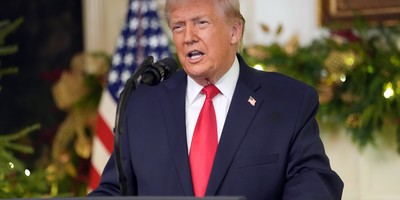Editor's note: This piece was co-authored by Craig Rucker.
The eighteenth Conference of Parties to the Kyoto Protocol (COP-18) has ended. It was the latest chapter in the interminable negotiations over wealth redistribution and control of energy use and economic growth – in the name of preventing “dangerous manmade global warming.”
For people who believe humans can prevent “catastrophic climate change” by adjusting atmospheric carbon dioxide levels by a few parts per million – or are determined to crave control “destructive” fossil fuels and “unsustainable” economic systems –
Only 37 of 194 nations signed the treaty that replaces the Kyoto Protocol, which expires December 31 – and several countries may withdraw their consent. That means the new agreement is legally non-binding and covers only 15% of global carbon dioxide emissions.
While the European Union joined in and remains committed to “carbon trading” (making former UNFCC chair Yvo DeBoer happy in his new role as a carbon trader, á la Al Gore), the United States, Brazil, Russia, India, China, Canada, Japan and other major emitters refused to sign, and the new treaty sets no binding emission limits. Atmospheric CO2 levels will thus continue to climb – and climate campaigners will remain distraught over allegedly disastrous weather events, imminent habitat devastation, species extinctions, injustice for the world’s poor, and the disappearance of island nations beneath the waves.
For those who say computer models are meaningless, climate change and weather extremes are natural, and economic growth should be sustained to lift more billions out of poverty – Doha represents a partial success. Few nations signed the treaty, even the Obama Administration did not commit to it, the document is not binding, and countless billions of dollars will be available for continued economic development and disaster relief – instead of being squandered on fruitless attempts to control Earth’s infinitely complex climate and weather.
Recommended
Even Christina Figueres, DeBoer’s successor at the UN Framework Convention on Climate Change, could proclaim victory. She wants to keep the planet’s temperature from rising more than the internationally agreed maximum of two degrees Celsius. That goal has arguably been reached already. There has been no detectable increase in average global temperatures for 16 years.
In fact, while last summer was hot and dry in much of the continental USA, nearing records set during the Dust Bowl years of the 1930s, it was a very cold summer in Alaska and parts of Europe. Winter 2012 was snowy and nasty in Central Europe and very cold in South Africa and South America. Britain just had its coldest autumn in nineteen years, Himalayan glaciers are growing, interior Greenland is not melting, summer Antarctic sea ice is near record extent, and seas are not rising any faster.
All this helps explain why climate alarmists keep changing their rhetoric: from global cooling to global warming, to climate change to climate disruption, and now to extreme weather. Indeed, they now try to link every unusual weather event to CO2 (and now methane, or natural gas, the fuel produced through hydraulic fracturing or fracking). However, as Dr. Roger Pielke, Jr. has noted, when the Atlantic hurricane season starts next June 1, it will have been 2,777 days since a category 3, 4 or 5 hurricane made landfall along the U.S. coast – the longest such period since 1900. 2012 also marked the quietest U.S. tornado season on record; only twelve tornadoes touched down in the United States in July 2012.
Of course, there are always disasters and human tragedies at the hands of a not-always-benevolent Mother Nature. Hardly a year has ever gone by without many such weather events somewhere on Planet Earth.
This year, however, climate alarmists have blamed virtually all of them on humans and CO2 emissions – from Sandy in the USA to 2011 and 2012 typhoons in the Philippines, and droughts in Africa. It’s easy to see why. As a Greenpeace director cogently explained, “The key issue is money” – as in the redistribution of wealth from rich, formerly rich and soon-to-be formerly rich nations to still poor countries. The other issue is power and control: as in who gets to make energy, economic, and human health and welfare decisions: individuals, families, communities and nations – or eco-activists and UN bureaucrats.
That brings us to the in-between: the uncharted waters separating “bitter failure” and “partial success.”
As climate activists and media “journalists” have observed, there is no legally binding agreement on reducing greenhouse gas emissions. The world’s two biggest CO2 emitters, China and the United States, did not sign. What was agreed to contains only vague promises that, “beginning in 2020, at least $100 billion a year will flow from public, private and other sources” to poor countries, supposedly to help them cope with the “devastating effects” of climate change and “extreme weather.” There is no agreement as to where that $1 trillion per decade will come from, or how much will be available annually between now and 2020, especially if the global economic downturn continues.
But don’t believe the vague promises, bitter failure, bitterly disappointed rhetoric. The climate alarmists got a lot of what they came for, they gave up little or nothing, they’ll be back for more, and in the meantime they will still get billions of dollars annually from taxpayers – to conduct climate change causation, mitigation, adaptation and compensation “research,” issue “balanced reports,” and attend many more conferences (all expenses paid) where virtually
More than 7,000 environmental NGO activists attended the Doha confab – and next time around they won’t forget who sent them, now that Jonathan Pershing, chief U.S. negotiator for climate change at Doha, has pointedly reminded them who paid for their presence in Qatar. They and the official delegates will be there for specific objectives: more money, more power, more control.
In Doha, they reached several benchmarks that they had achieved during previous COP events. Most important, they enshrined in the treaty the concept of “loss and damage” supposedly resulting from “manmade climate change” – and secured pledges from “rich” nations that poor countries would receive billions of dollars per year in “aid” to repair any “loss and damage,” as part of a “climate compensation mechanism.” They also incorporated “principles” of “equity” and “justice” and “common but differentiated responsibilities” – to distinguish between nations that “caused” climate change and “extreme weather events” and countries that presumably did not or are “especially vulnerable.”
It is true that words like “compensation,” “fault” and “liability” were excised from the final treaty language – and that it will be all but impossible to determine how much, if any, loss and damage from a tornado, hurricane, typhoon, flood or drought was due to “manmade climate change” versus how much from natural climate change and natural, normal extreme weather events. Who will pay how much, from existing aid programs versus new programs, and through what UN or other conduits, will likewise have to be decided at one of the presumably many future Conferences Of Parties to the new climate agreement.
“This is just the beginning of the process,” a Greenpeace activist, helpfully explained.
Indeed, the “parties” – and thus their taxpayers, food and energy consumers, and citizens hoping to pursue their dreams – are slowly but surely, piece by piece, surrendering their rights, freedoms, sovereignty and hard-earned wealth to a gaggle of unelected and unaccountable activists, agitators, bureaucrats, autocrats and kleptocrats. The slippery slope is just ahead, if we are not already on it.
The scientific case for manmade global warming disasters grows weaker by the day. But no one should ever underestimate the desperation, audacity and political brilliance of those who have staked their careers, reputations, salaries and pensions on the notion that our energy use and quest for improved living standards for all humanity have somehow usurped the natural forces that have driven climate changes from time immemorial. We underestimate the alarmists at our peril.

























Join the conversation as a VIP Member